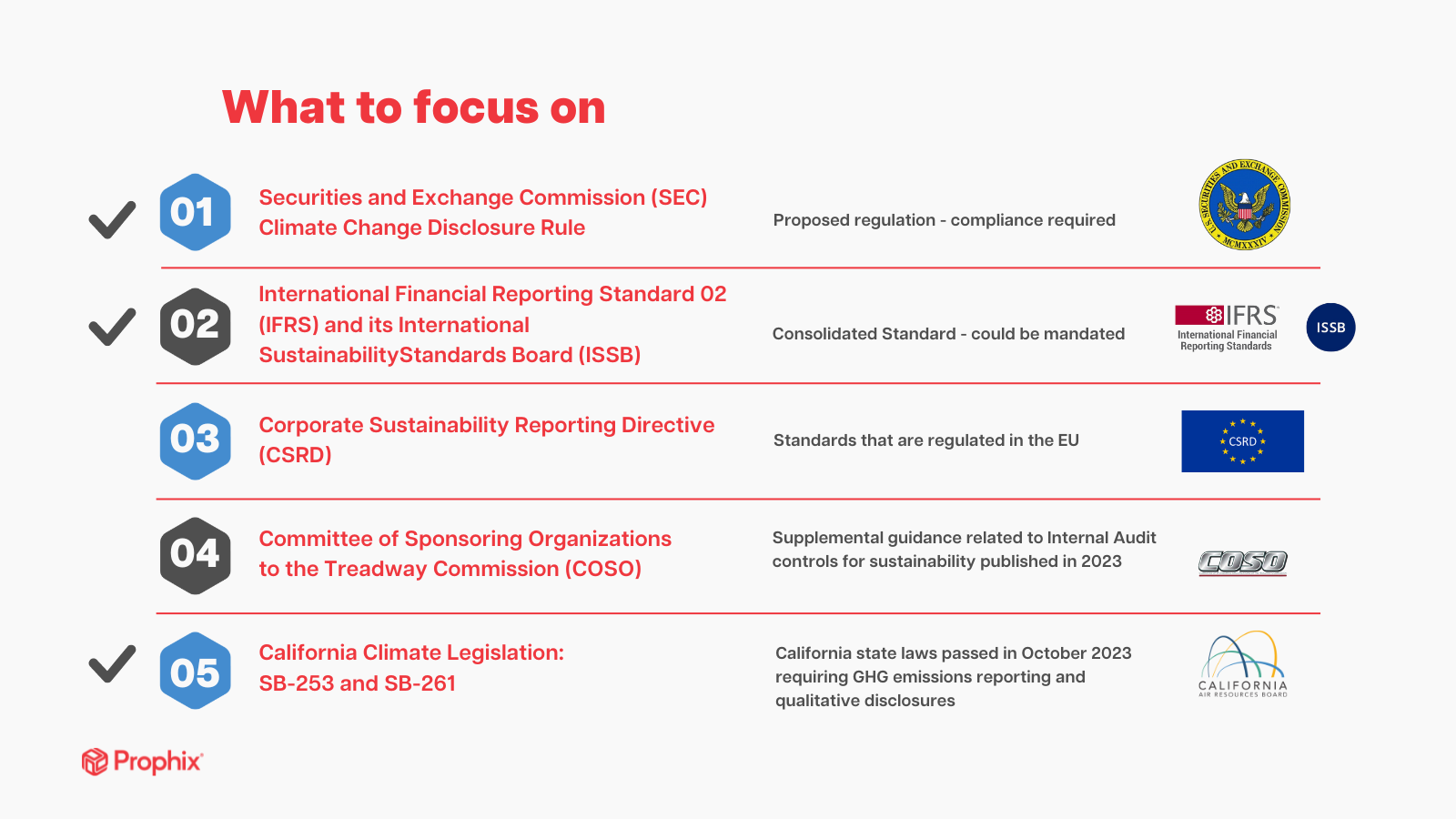3 key ESG takeaways for 2024 and beyond
Keeping up with changing regulatory requirements is time-intensive and challenging, especially without the right tools and processes in place.
In our recent webinar on year-end close, audits, and regulatory reporting, we covered how to keep pace with the regulatory landscape—particularly ESG. Turns out, it’s a fast-moving domain, and having processes, systems, and tools at the ready can be a game-changer.
In this article, we’ll look at:
- What is regulatory reporting?
- ESG landing in the Office of the CFO
- ESG as a risk management tool
- ESG as a business strategy and opportunity
- Regulatory reporting is a journey, not a destination
What is regulatory reporting?
At its core, regulatory reporting is a system of collecting and submitting data to regulatory bodies, like the SEC. Regulatory reporting is a process that company’s use to demonstrate that their financial and operational activities are compliant with standards and regulations.
Regulatory reporting is intended to improve transparency and helps establish trust between companies, competitors, and consumers.
For example, regulatory reporting includes:
- Environmental, Social, and Governance (ESG) reporting
- International Financial Reporting Standards (IFRS) accounting rules
- Generally Accepted Accounting Principles (GAAP) accounting rules
- Global Minimum Tax (Pillar 2) rules
According to Stephen Lathrop, Managing Director at UHY Consulting, he noted these regulations as the key to focus on:

Learn more in the full webinar on how to get ahead of regulatory reporting requirements in 2024.
Now that we’ve covered the regulatory reporting basics, let’s look at the top 3 ESG takeaways from our recent webinar—and what this means for finance leaders.
1. ESG is landing in the Office of the CFO
Sustainability and ESG reporting is landing in the Office of the CFO. As organizations scale, they are looking at ESG through a lens of financial due diligence, insurance, and the financial impact on the company.
As the regulatory landscape evolves, ESG is becoming a business consideration and a financial consideration. Frameworks and standards are consolidating, regulations are coming into play, and more are to come. This means finance teams are at an inflection point: use this as a chance to get ahead—or you might fall behind.
There is mounting pressure from consumers and investors—whether that’s private equity, publicly traded, loans, or green bonds. This means that finance teams are even more attuned to the risks that climate change imposes on companies. And more importantly, companies need to have a strategy in place. From consumers to boards, investors, and banks, there are eyes on ESG and how organizations are incorporating sustainability reporting into their business strategy.
2. ESG is a risk management tool
As climate change and other environmental, social, and governance risks increase, ESG is evolving as a new way to look at risk management. By definition, enterprise risk management (ERM) is the method and processes used to manage risks and identify opportunities. ERM is a “top-down strategy that aims to identify, assess, and prepare for potential losses, dangers, hazards, and other potentials for harm.”
When a company incorporates ESG reporting into their business strategy, the ESG scores bring to the surface how a company handles risks and associated concerns.
ESG as a risk management tool is forcing organizations to ask questions like:
- Am I prepared to continue operations in the face of changing environmental impacts?
- What questions are my investors asking around environmental, social, or governance impacts?
- What questions are consumers asking and how do I respond?
3. ESG is a business opportunity
Regulations can sometimes feel like you are navigating your way through alphabet soup. But the increasing complexity and volume of regulations has led many organizations to say they’re not going to tackle regulatory reporting until they have to do it. But the truth is: Organizations who embrace ESG and other forms of regulatory reporting before it’s mandated can use it as a competitive advantage.
Previously, ESG was seen as a nuisance. It wasn’t just that teams weren’t prepared or efficient. It’s a combination of bandwidth and technology constraints holding teams back too. Now, businesses are finding a way to turn ESG and other standards and regulations into an opportunity.
Businesses who listen to their consumers are noting a consistent message from them: ESG is important; it influences consumers in their choices. This has effects both upstream and downstream. Businesses are creating ESG strategies to line up with consumer behaviors. Upstream vendors are asking suppliers for ESG strategies in order to do business with them. Outside of requirements from regulatory bodies, companies are implementing their own ESG requirements—and they’re using it as a competitive advantage and a business strategy.
Conclusion: Regulatory reporting is a journey, not a destination
Regulatory reporting is a journey, not a destination. It’s not a one-time effort, it’s constantly evolving. When you’re faced with a change in reporting strategy or new regulations, it can be hard to determine where to start and the full level of detail you need to uncover. The advice from our webinar presenters: don’t see regulatory reporting as only a steep path to climb. The best way forward is to break down the requirements into smaller, digestible pieces with a moving target. And to make it an easier task, a financial performance platform like Prophix is a key part of the process.
To blaze a trail forward, finance teams should take the lead on regulatory reporting. But it's not solely a finance project or obligation. Regulations are a collaborative effort that should bring a cross-functional team together. It’s important to evaluate the impact and input from different departments and make it clear that everyone has accountability on the journey of regulatory reporting.
A well-informed tech strategy can help you address your regulatory reporting strategy. Modern technology integrates your data sources and speeds up data collection so you can focus on analyzing results, building your business strategy, and getting ahead of your competitors.
